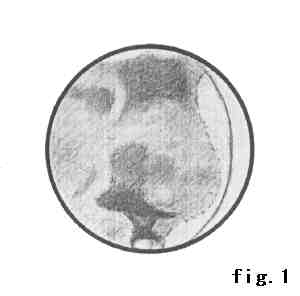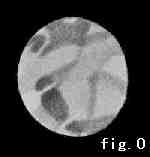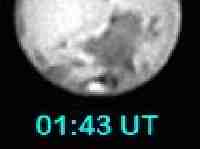
 It is well known that the northern part of M Acidalium is seen frequently separated from Hyperboreus L which encircles darkly the north polar cap. For instance Tsuneo SAHEKI observed this aspect by the use of an 8cm Newtonian at the season 141degsLs in 1935 when the apparent diameter =10.9" (at the magnification 200x ). See Fig. 0.
It is well known that the northern part of M Acidalium is seen frequently separated from Hyperboreus L which encircles darkly the north polar cap. For instance Tsuneo SAHEKI observed this aspect by the use of an 8cm Newtonian at the season 141degsLs in 1935 when the apparent diameter =10.9" (at the magnification 200x ). See Fig. 0.

In 1997, our colleague Hiroshi ISHADOH (Id) observed frequently the shadowy bands including Iaxartes within the slit. For example, see Id's drawing cited in #201 at p2244 which was taken on 30 Mar 1997 (094degsLs) at LCM=069degsW. We also referred in #191 p2093 to his observation made on 12 May 1997 (117degsLs) at LCM=034degsW, which we cite here as Fig 1. This should be compared with an HST image taken on 17 May 1997 (119degsLs) as cited in #193 p2137. The season was near and the composition is similar. Id's earlier drawing on 25 Feb (083degsLs) of the area is found in #186 p2018, but the slit is shadowy and Iaxartes was not detected.
Fig 1: ISHADOH's drawing on 12 May 1997
(117degsLs) at LCM=034degsW when the apparent diameter =10.6"
The slit between M Acidalium and Hyperboreus L is not however always evident. Contrarily the slit area must originally be shadowy if not invaded by any mist or cloud. For example, the excellent Red image by Jim BELL on 17 Feb 1997 (080degsLs) cited in #185 p2011 does not show the slit.
 As Fig 2 we cite two HST images on 30 Dec 1996 (058degsLs) and on 27 June 1997 (139degsLs) for comparison. Apparently the slit is rather obscure in the former (partly cloud invaded), though Iaxartes is darker evident. On the other hand, the area sometime appears as a complete slit because the area is haunted by a white haze by which Iaxartes and others are erased. The image on 27 June shows the case. Compare further with the HST image on 17 May at p2137 in #193.
As Fig 2 we cite two HST images on 30 Dec 1996 (058degsLs) and on 27 June 1997 (139degsLs) for comparison. Apparently the slit is rather obscure in the former (partly cloud invaded), though Iaxartes is darker evident. On the other hand, the area sometime appears as a complete slit because the area is haunted by a white haze by which Iaxartes and others are erased. The image on 27 June shows the case. Compare further with the HST image on 17 May at p2137 in #193.
Fig 2: HST images of the area on
30 Dec 1996 (058degsLs) (left) and 27 June 1997 (139degsLs) (right)
Our earlier examples are also in #162 (25 Mar 1995) p1645: one was taken on 20 Apr 1995 (087degsLs), and the other on 21 Mar 1982 (101degsLs).
 We finally recall another interesting fact revealed by a CCD image on 16 Mar (091degsLs) at LCM=008degsW by the SGPG including G QUARRA (cf #188 p2055). This implies Iaxartes runs further into Hyperboreus L while its density remains weaker than that of Hyperboreus (as was also pointed on the occasion of CMO Meeting in January: see #199 p2214). This fact is not necessarily apparent in the HST images, but may be connected with some pleats revealed by Vikings (see for example Fig 3 in #177 p1872). The processing effect is another possibility and hence more CCD images of the region are expected in 1999.
We finally recall another interesting fact revealed by a CCD image on 16 Mar (091degsLs) at LCM=008degsW by the SGPG including G QUARRA (cf #188 p2055). This implies Iaxartes runs further into Hyperboreus L while its density remains weaker than that of Hyperboreus (as was also pointed on the occasion of CMO Meeting in January: see #199 p2214). This fact is not necessarily apparent in the HST images, but may be connected with some pleats revealed by Vikings (see for example Fig 3 in #177 p1872). The processing effect is another possibility and hence more CCD images of the region are expected in 1999.
Fig 3: SGPG's CCD image on 16 Mar 1997
(091degsLs) at LCM=008degsW by a 42cm refr at Torino